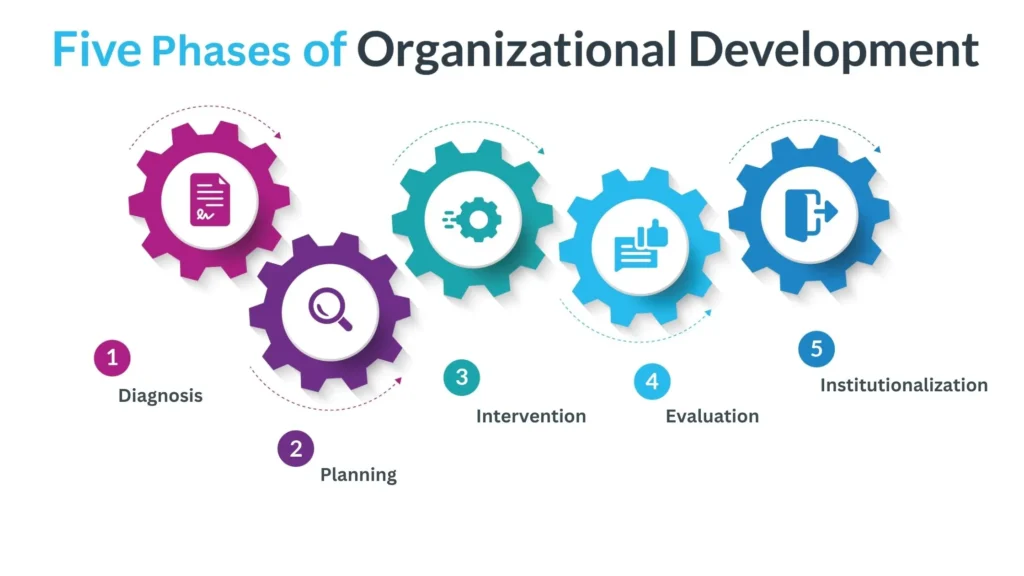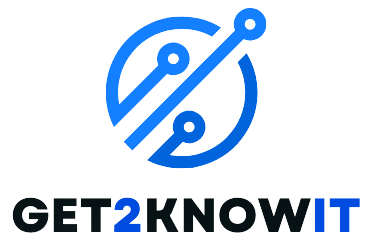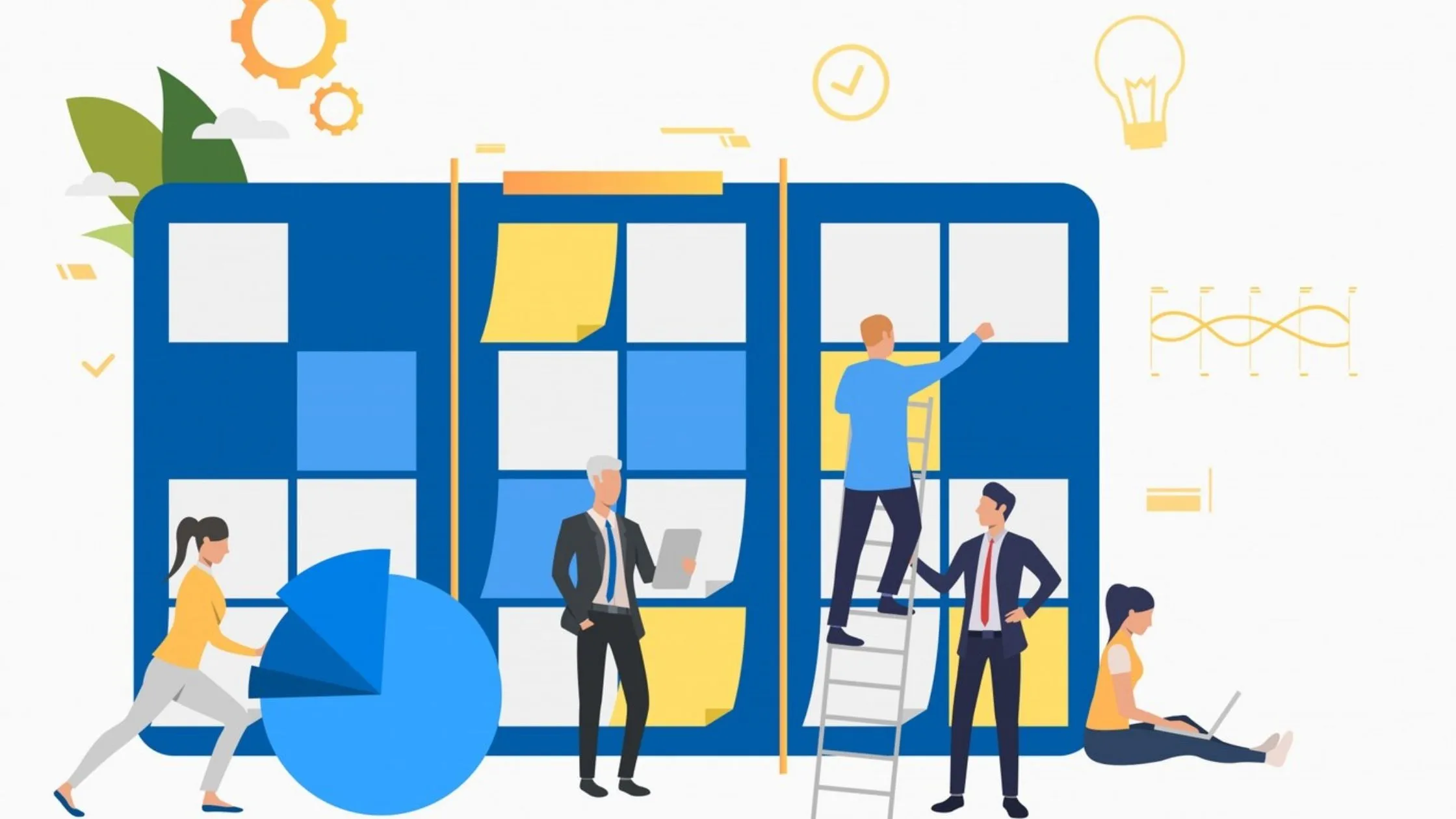Organizational Development is like a thoughtful plan to make a company work better. It’s about making sure everyone, the way things are done, and the feel of the company all work together to reach specific goals. OD includes different practices, such as helping with changes, getting employees excited about their work, and making leaders better. In today’s fast and competitive business world, OD is super important.
It helps companies be ready for changes, keeps employees happy and working well, encourages new ideas, and makes a strong base for long-term success. Basically, by always trying to get better and making sure everything fits together well, OD becomes a really important tool for companies that want to do well in a constantly changing business world.
The Five Phases of Organizational Development
The five phases of organizational development (OD) provide a systematic approach for the creation and the management of change in an organization.
Diagnosis:
At first, organizations measure the level of performance by assessing their strengths, weaknesses, opportunities and threats. This stage includes studying everything in detail to determine why change is necessary.
Planning:
Having determined what modification is necessary, organizations progress to the planning stage. Here, they set out clearly what needs to be done to improve, by setting goals, allocating roles and identifying what changes should be made.

Intervention:
Now, it is time to execute these plans. This stage involves the implementation of the planned changes. Changing the structures, processes or the culture whatever it is a successful transition should involve good communication and employee’s involvement.
Evaluation:
Organizations next evaluate whether the changes are effective. They look at whether the objectives were achieved and if modifications are required. Evaluation offers informative observations that make the changes even better.
Institutionalization:
The final stage is related to establishing the features as permanent elements of organizational practices. This guarantees long-term naturalness of the improvements in the organization.
The next statement is the five stages that these organizations are guided through a structured process that helps them adapt to changes, improve their effectiveness, and remain relevant over time.
Organization Development Models
Lewin’s Change Management Model
Kurt Lewin created a simple three-step plan for making big changes in organizations.
- Unfreeze: Recognize the need for change and get the organization ready by breaking old ways of thinking.
- Change: Put the planned changes into action.
- Refreeze: Make sure the organization stays stable in its new state, so the changes become the usual way of doing things.
Burke-Litwin Model
The Burke-Litwin Model shows how the different parts of an organization are interdependent. It breaks down the factors into two types: Transformation (big changes) and transactional (day-to-day operations). This model, containing 12 significant factors, is like a map that indicates how one thing influences another within the organization. It assists organizations in understanding why changes occur and how one change can cause another.
Action Research Model
As a teamwork-oriented strategy, Action Research is used to help people settle their issues and improve organizations. It is a sequenced procedure which includes planning, doing something and observing its outcomes and finally reflect. This occurs in a circular motion, providing continuous learning and adaptation to respond to the changing stimuli.
These models give organizations helpful structures to manage change well. They can be used for planned improvements, understanding the intricate workings of an organization, or building a culture of constant improvement. Each model brings different viewpoints and methods, letting organizations pick the one that fits their needs best.
Organizational Development and Leadership
Successful leaders guide the way, motivate their teams, and make important decisions key aspects of effective Organizational Development (OD). Leadership is crucial for a company’s growth as it ensures teams work efficiently and productively. Leaders play a vital role in boosting each team member’s productivity, making a big impact on the organization’s success.
Their influence goes beyond day-to-day tasks; leaders drive change and shape the company’s culture, acting as the main force behind its development. Leadership development, closely linked with organizational development, aims to improve leaders’ skills. The goal is to help leaders build strong connections with their teams and establish workplaces where employees feel appreciated and valued.
Employee Engagement and OD
Encouraging employees to be engaged is really important for making a happy workplace and helping the organization do well. When employees are engaged, they tend to feel excited, get more work done, and really care about reaching the organization’s goals. Ways to make employees more engaged, which are part of organizational development plans, include having open communication, giving recognition, providing chances for professional growth, and creating a supportive work atmosphere.
When employee engagement is part of these plans, it makes everyone happier, helps people work together better, and builds a strong and flexible workplace culture. This all leads to the organization doing even better overall and being able to handle changes in the business world more easily.
Latest Trends in Organizational Development
Current OD trends demonstrate how workplaces experience and react to the high-speed business world of today. Here are some important trends:
- AI and automation
- Adopting Hybrid Work (which includes both virtual and office work)
- Emphasizing on teamwork
- Enhancing Employee Engagement
- Developing Leadership Skills
- Agile and Flexible OD Practices
- Prioritizing Diversity, Equity, and Inclusion
- Embracing Digital Transformation and Analytics
- Providing Executive Coaching
- Building Change Agility
All these trends combined contribute to flexible, diverse and modern working environments. This helps organizations adapt and survive in a volatile world.
Career in Organizational Development
Organizational Development professionals who generally have degrees in human resources, psychology or business are the people behind positive changes made at work. They improve employee involvement and ensure the organization’s strategies are implemented as planned. Their role may include identifying what the organization requires, designing and implementing initiatives to improve things, as well as measuring the effectiveness of these changes. If they operate from within an organization or as external experts, these OD professionals help build effective, adaptable and productive workplaces.




